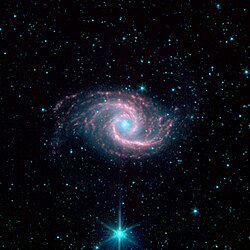NGC 1566
| NGC 1566 | ||
|---|---|---|
 | ||
| Datos de observación (época J2000.0) | ||
| Tipo | SAB(rs)bc | |
| Ascensión recta | 04h 20m 00.4s | |
| Declinación | -54° 56' 16" | |
| Distancia | 50 millones de al | |
| Magnitud aparente (V) | 10,3 | |
| Tamaño aparente (V) | 8,3' × 6,6' | |
| Constelación | Dorado | |
| Características físicas | ||
| Magnitud absoluta | - | |
| Radio | - | |
| Otras características | ||
| - | ||
| Otras designaciones | ||
PGC 14897 | ||
NGC 1566, popularmente conocida como la galaxia del bailarín español[1][2], es una galaxia espiral intermedia que se encuentra a una distancia de entre 20[3] y 70[4] millones de años luz en la constelación austral de La Dorada (Dorado)[2]. Por brillo y masa es, junto con NGC 1553, el miembro más destacado del grupo Dorado de galaxias.
Vista de frente desde nuestra perspectiva, presenta un diámetro de 100.000 años luz, concentrándose la formación estelar en los brazos espirales. Las características del núcleo, pequeño pero muy luminoso, sugieren que se trata de una galaxia activa de tipo Seyfert[5]. De acuerdo con su espectro, el gas caliente alrededor del núcleo se mueve a una velocidad anormalmente alta, interpretándose que está orbitando un agujero negro supermasivo cuya masa se ha estimado en (8.6 ± 4.4) × 106 masas solares[6].
Véase también
[editar]Referencias
[editar]- ↑ «NGC 1566: la galaxia espiral del bailarín español | Imagen astronomía diaria - Observatorio». 2 de julio de 2019. Consultado el 17 de enero de 2022.
- ↑ a b «APOD: 2022 January 14 - NGC 1566: The Spanish Dancer Spiral Galaxy». apod.nasa.gov. Consultado el 15 de enero de 2022.
- ↑ Slater, R.; Nagar, N. M.; Schnorr-Müller, A.; Storchi-Bergmann, T.; Finlez, C.; Lena, D.; Ramakrishnan, V.; Mundell, C. G. et al. (2019-01). «Outflows in the inner kiloparsec of NGC 1566 as revealed by molecular (ALMA) and ionized gas (Gemini-GMOS/IFU) kinematics». Astronomy & Astrophysics 621: A83. ISSN 0004-6361. doi:10.1051/0004-6361/201730634. Consultado el 17 de enero de 2022.
- ↑ Kilborn, V. A.; Koribalski, B. S.; Forbes, D. A.; Barnes, D. G.; Musgrave, R. C. (1 de enero de 2005). «A wide-field HI study of the NGC 1566 group». Monthly Notices of the Royal Astronomical Society (en inglés) 356 (1): 77-88. ISSN 0035-8711. doi:10.1111/j.1365-2966.2004.08450.x. Consultado el 17 de enero de 2022.
- ↑ Agüero, E. L.; Díaz, R. J.; Bajaja, E. (2004-02). «NGC 1566: Spectroscopy of a symmetric system with Seyfert nucleus». Astronomy & Astrophysics 414 (2): 453-461. ISSN 0004-6361. doi:10.1051/0004-6361:20031644. Consultado el 17 de enero de 2022.
- ↑ Smajić, S.; Moser, L.; Eckart, A.; Busch, G.; Combes, F.; García-Burillo, S.; Valencia-S., M.; Horrobin, M. (2015-11). «The nuclear gas disk of NGC 1566 dissected by SINFONI and ALMA». Astronomy & Astrophysics 583: A104. ISSN 0004-6361. doi:10.1051/0004-6361/201424850. Consultado el 17 de enero de 2022.
Enlaces externos
[editar]Text is available under the CC BY-SA 4.0 license; additional terms may apply.
Images, videos and audio are available under their respective licenses.
